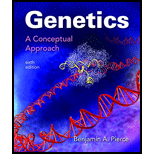
To explain:
The thrifty phenotype hypothesis.
Introduction:
Explanation of Solution
The thrifty phenotype hypothesis suggests that if there is a decrease in the fetal development then it is associated with the chronic condition throughout its life. This means if the environmental conditions are chronic during fetal growth, then it is expected that these conditions are likely to persist in its adult life as well.
To explain:
How thrifty phenotype hypothesis helps to explain the long-term effects of famine on people conceived during the Dutch Hunger Winter.
Introduction:
The thrifty phenotype hypothesis proposes that a reduction in the fetal development of an individual is most often associated with the chronic condition throughout his life.
Explanation of Solution
The thrifty phenotype hypothesis explains the long-term effects of famine (extreme scarcity of food) on the people who were conceived during the Dutch Hunger Winter. These effects occur due to the epigenetic changes in the genome of the people.
According to the thrifty phenotype hypothesis, if the environmental conditions are poor during the fetal development then these conditions are usually present in its adult life as well. Various studies have shown these individuals who are now adults experienced the caloric restriction while in the womb during the famine that had life-long consequences. For example – a man and women who conceived and underwent early fetal development during famine were likely to increase the susceptibility of adopting conditions such as cardiovascular disease, diabetes, and hypertension.
Hence, a person who conceived during famine was likely to increase the susceptibility of cardiovascular disease, diabetes and hypertension. In this way thrifty phenotype hypothesis helps to explain the long-term effects of famine on the people who were conceived during the Dutch Hunger Winter.
Want to see more full solutions like this?
Chapter 21 Solutions
Genetics: A Conceptual Approach
 Human Anatomy & Physiology (11th Edition)BiologyISBN:9780134580999Author:Elaine N. Marieb, Katja N. HoehnPublisher:PEARSON
Human Anatomy & Physiology (11th Edition)BiologyISBN:9780134580999Author:Elaine N. Marieb, Katja N. HoehnPublisher:PEARSON Biology 2eBiologyISBN:9781947172517Author:Matthew Douglas, Jung Choi, Mary Ann ClarkPublisher:OpenStax
Biology 2eBiologyISBN:9781947172517Author:Matthew Douglas, Jung Choi, Mary Ann ClarkPublisher:OpenStax Anatomy & PhysiologyBiologyISBN:9781259398629Author:McKinley, Michael P., O'loughlin, Valerie Dean, Bidle, Theresa StouterPublisher:Mcgraw Hill Education,
Anatomy & PhysiologyBiologyISBN:9781259398629Author:McKinley, Michael P., O'loughlin, Valerie Dean, Bidle, Theresa StouterPublisher:Mcgraw Hill Education, Molecular Biology of the Cell (Sixth Edition)BiologyISBN:9780815344322Author:Bruce Alberts, Alexander D. Johnson, Julian Lewis, David Morgan, Martin Raff, Keith Roberts, Peter WalterPublisher:W. W. Norton & Company
Molecular Biology of the Cell (Sixth Edition)BiologyISBN:9780815344322Author:Bruce Alberts, Alexander D. Johnson, Julian Lewis, David Morgan, Martin Raff, Keith Roberts, Peter WalterPublisher:W. W. Norton & Company Laboratory Manual For Human Anatomy & PhysiologyBiologyISBN:9781260159363Author:Martin, Terry R., Prentice-craver, CynthiaPublisher:McGraw-Hill Publishing Co.
Laboratory Manual For Human Anatomy & PhysiologyBiologyISBN:9781260159363Author:Martin, Terry R., Prentice-craver, CynthiaPublisher:McGraw-Hill Publishing Co. Inquiry Into Life (16th Edition)BiologyISBN:9781260231700Author:Sylvia S. Mader, Michael WindelspechtPublisher:McGraw Hill Education
Inquiry Into Life (16th Edition)BiologyISBN:9781260231700Author:Sylvia S. Mader, Michael WindelspechtPublisher:McGraw Hill Education





